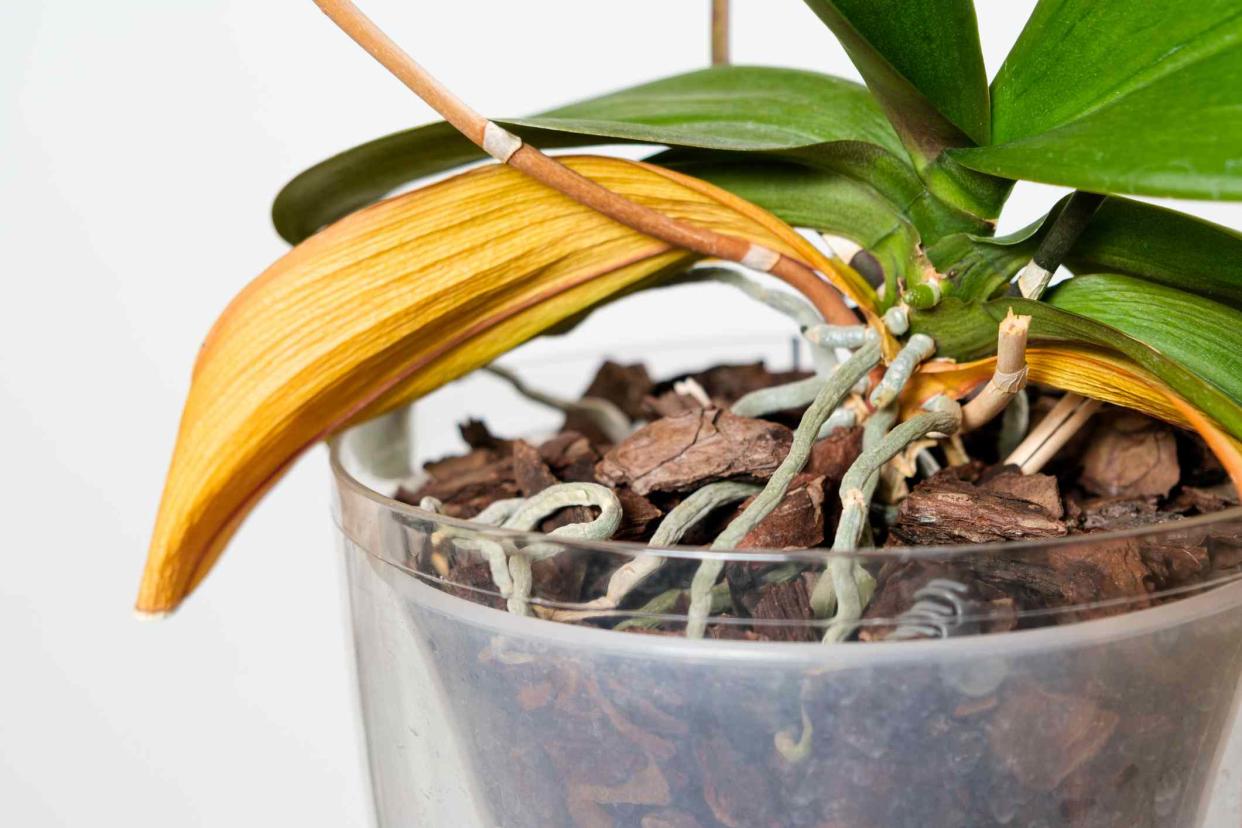11 Reasons Why Your Orchid's Leaves Are Droopy

Zarina Lukash / Getty Images
Orchid leaves can tell you quite a bit about the plant's health. While most aren't especially attractive by themselves, leaves provide clues when something is affecting the orchid's health. Droopy leaves are an early sign you need to investigate and take action. Here are 11 causes of droopy orchid leaves and what you can do to alleviate the problem.
Overwatering
Inspect roots to check for overwatering. Healthy roots are green or silvery green and plump. Soft, dark colored roots can't take up nutrients to feed leaves which causes wilting. When the pot is sitting in water, or feels heavier than normal, the orchid is likely oversaturated.
Prune out damaged roots. In severe cases you may need to treat with a fungicide to prevent root rot. If the potting medium is soggy, repot in fresh dry material. If you suspect overwatering but roots are healthy, allow the potting mix to dry out and reduce watering frequency.
Underwatering
Inspecting roots can also tell you when the plant is too dry. Dark colored roots that are shriveled, brittle and flat indicate a lack of moisture. Soak the pot in water for 10 to 15 minutes to saturate the roots. Prune damaged roots back to healthy tissue and soak more frequently—some orchids need water two to three times weekly.
Watering Improperly
Effective orchid watering drenches the potting mixture enough to remain moist for several days. At the same time, excess water should drain away, so plant in a pot with good drainage. Set the pot under a faucet for a minute or two, then drain excess before returning the plant to its saucer. You can also soak the pot for several minutes. Water aerial roots but avoid wetting the crown, leaves, and stems.
Room temperature water is best. If your tap water is heavily treated, try using distilled or rainwater.
Watering Orchids
A watering schedule is key to orchid health. Grown in pots, orchids require light, usually soilless medium that drains well. The challenge is finding the right balance because these potting mixes dry out fairly quickly. Watering frequency can vary slightly depending on species, but most grow in a rainforest environment with plenty of moisture and humidity.
Temperature Fluctuations
Orchids thrive in specific temperature ranges, with nighttime temperatures around 10 degrees F. lower than during the day. Temperature extremes and wide fluctuations can cause leaves to droop.
Plenty of species thrive in the same spot in your home so finding the ideal location usually eliminates this problem. If you've ruled out a watering issue, check to see if you've set your plant near an air vent, heat source or too close to an open window, If you notice leaves drooping when seasons change, you may need to select different locations for summer and winter.
Air Circulation
Leaves and aerial roots absorb moisture and nutrients from the air, so adequate circulation is important. Open spaces with fans improve circulation. Ceiling fans are ideal but floor fans also work as long as they don't point directly onto the orchid.
Humidity
Humidity levels of 40 to 70 percent are adequate for most orchids, whose native habitats are humid. If air is too saturated, leaf surfaces may show beaded moisture which can result from misting. Release mist into the area around the orchid, never directly onto it. If humidity is low, try setting the pot on a layer of moistened gravel or install a humidifier.
Air Pollutants
Avoid keeping your orchid in a room, such as a kitchen, where appliances can affect air quality. Ethylene, emitted by appliances such as pilot lights, stoves, and heaters, is of particular concern, causing older leaves to yellow and fall off. Avoid using room sprays and cleaning agents around your plant.
Too Much Light
Different orchids have different light requirements but almost all thrive best with indirect light. Direct or too much bright light causes drying and sunburn which show up as dark, flaky spots on leaf tips and margins. Let affected leaves mature and fall naturally instead of cutting out damaged parts. Move the plant to a location with indirect light.
Inadequate Light
Inadequate light levels and length of exposure slow photosynthesis and growth. Leaves become chlorotic and yellow. Leaves that are entirely yellow can be removed, but a leaf that's only slightly faded can recover. Move the orchid to a new spot that better meets its light requirement or add a grow light.
Nutrition
Orchids need energy to produce their spectacular blooms. Potting mixes don't provide much nutrition so fertilizing is an important part of maintenance. Nutrient deficiencies result in fewer blooms, smaller plants, and weak leaves.
Increase feeding frequency with fertilizer specifically for orchids or a balanced houseplant fertilizer diluted from 1/4 to 1/2 strength. How often you should fertilize, from weekly to monthly, depends on species and variety. Always water before fertilizing.
Insect Pests
Sap sucking insects cause leaves to wilt. Chlorotic spots are a sign this could be the problem. Eventually leaves darken, wilt and drop.
Check regularly for pests. Look for cottony webbing and discoloration on the undersides of leaves and the junction of leaves and stems. Isolate the plant and treat with horticultural oil or a mild soap solution.
Frequently Asked Questions
Will droopy orchid leaves recover?
If the leaf is only slightly faded and hasn't turned yellow, there is a chance and orchid leaf can recover. If it's beyond help, remove it entirely instead of cutting out just the damaged portion.
What do overwatered orchid leaves look like?
Overwatered orchid leaves look wrinkled with prominent veins and feel soft and floppy. They often have a yellowish hue or appear faded.
Read Next: How to Grow and Care for Phalaenopsis Orchids Indoors

